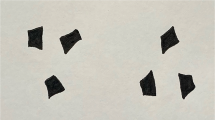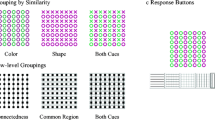Abstract
Palmer and Rock proposed that uniform connectedness (UC) occurs prior to classical Gestalt factors to define the primitive units for visual perception. Han, Humphreys and Chen, however, found that grouping by proximity can take place as quickly as that based on UC in a letter discrimination task. The present study employed a letter detection task to examine the relationship between UC and proximity grouping in 3 experiments. We showed that reaction times to targets defined by proximity or UC were equally fast when one or two global objects were presented in the visual field. However, as the number of global objects was increased, responses were faster to targets defined by UC than to targets defined by proximity. In addition, the advantage of UC over proximity was not affected by the space between global objects. The results suggest that UC was more effective than proximity in forming perceptual units under multiple object conditions. Possible reasons for this finding are discussed.
Similar content being viewed by others
References
Marr, D., Vision, San Franciso: W. H. Freeman, 1982.
Kohler, W., An aspect of Gestalt psychology, in Psychologies of 1925 (ed. Murchison, C.), Worcester, MA: Clark University Press, 1928, 163–195.
Wertheimer, M., Untersuchungen zur Lehre von der Gestalt: II. Psychologische Forshung, 1923, 4: 301–350.
Palmer, S., Common region: Anew principle of perceptual grouping, Cognitive Psychology, 1992, 24: 436–447.
Palmer, S., Rock, I., Rethinking perceptual organization: The role of uniform connectedness, Psychonomic Bulletin & Review, 1994, 1: 29–55.
Quinlan, P. T., Wilton, R. N., Grouping by proximity or similarity? Competition between the Gestalt principles in vision, Perception, 1998, 27: 417–430.
Ben-Av, M. B., Sagi, D., Perceptual grouping by similarity and proximity: Experimental results can be predicted by intensity autocorrelations, Vision Research, 1995, 35: 853–866.
Han, S., Humphreys, G. W., Chen, L., Uniform connectedness and classical Gestalt principles of perceptual grouping, Perception & Psychophysics, 1999, 61: 661–674.
Han, S., Humphreys, G. W., Interactions between perceptual organization based on Gestalt laws and those based on hierarchical processing, Perception & Psychophysics, 1999, 61: 1287–1298.
Han, S., Song, Y., Ding, Y. et al., Neural substrates for visual perceptual grouping in human, Psychophysiology, 2001, 38: 926–935.
Kimchi, R., Uniform connectedness and grouping in the perceptual organization of hierarchical patterns, Journal of Experimental Psychology: Human Perception and Performance, 1998, 24: 1105–1118.
Navon, D., Forest before trees: The precedence of global features in visual perception, Cognitive Psychology, 1977, 9: 353–383.
Han, S., Humphreys, G. W., Chen, L., Parallel and competitive processes in hierarchical analysis: Perceptual grouping and encoding of closure, Journal of Experimental Psychology: Human Perception and Performance, 1999b, 25: 1411–1432.
Kimchi, R., The perceptual organization of visual objects: A microgenetic analysis, Vision Research, 200, 40: 1333–1347.
Grice, G. R., Canham, L., Boroughs, J. M., Forest before trees? It depends where you look, Perception & Psychophysics, 1983, 33: 121–128.
Pomerantz, J. R., Global and local precedence: Selective attention in form and motion perception, Journal of Experimental Psychology: General, 1983, 112: 512–540.
Han, S., He, X., Yund, E. W. et al., Attentional selection in the processing of hierarchical patterns: An ERP study, Biological Psychology, 2001, 5: 113–130.
Han, S., Humphreys, G. W., Segmentation and selection contribute to local processing in hierarchical analysis, Quarterly Journal of Experimental Psychology, Section A, 2002, 55: 5–21.
Chun, M. M., Wolfe, J. M., Just say no: how are visual searches terminated when there is no target present? Cognitive Psychology, 1996, 30: 39–78.
Humphreys, G. W., Müller, H. J., Search via Recursive Rejection (SERR): A connectionist model of visual search, Cognitive Psychology, 1993, 25: 43–110.
Duncan, J., Humphreys, G. W., Visual search and stimulus similarity, Psychological Review, 1989, 96: 433–458.
Mack, A., Tang, B., Tuma, R. et al., Perceptual organization and attention, Cognitive Psychology, 1992, 24: 475–501.
Vecera, S. P., Farah, M. J., Is visual image segmentation a bottom-up or an interactive process? Perception & Psychophysics, 1997, 59: 1280–1296.
Kramer, A., Watson, S., Object-based visual selection and the principle of uniform connectedness, in Converging Operations in the Study of Visual Selective Attention (eds. Kramer, A., Coles, M., Logan, G.), Washington, D. C.: APA Press, 1996, 395–414.
Watson, S. E., Kramer, A. F., Object-based visual selective attention and perceptual organization, Perception & Psychophysics, 1999, 61:31–49.
Van Lier, R., Wagemans, J., Effects of physical connectivity on the representational unity of multi-part configurations, Cognition, 1998, 69: 1–9.
Saiki, J., Hummel, J. E., Connectedness and the integration of parts with relations in shape perception, Journal of Experimental Psychology: Human Perception and Performance, 1998, 24: 227–251.
Ginsburg, A. P., Spatial filtering and visual form perception, in Handbook of Perception and Human Performance (eds. Boff, K. R., Kaufman, L., Thomas, J. P.), New York: John Wiley & Sons, Inc., 1996, Chap. 34: 1–71.
Peterson, M. A., Object recognition processes can and do operate before figure-ground organization, Current Directions in Psychological Science, 1994, 3: 105–111.
Kahneman, D., Treisman, A., Burkell, J., The cost of visual filtering, Journal of Experimental Psychology: Human Perception and Performance, 1983, 9: 510–522.
Enns, J. T., Kingstone, A., Access to global and local properties in visual search for compound stimuli, Psychological Science, 1995, 6: 283–291.
Author information
Authors and Affiliations
Corresponding author
Rights and permissions
About this article
Cite this article
Han, S., Humphreys, G.W. Relationship between uniform connectedness and proximity in perceptual grouping. Sci. China Ser. C.-Life Sci. 46, 113–126 (2003). https://doi.org/10.1360/03yc9013
Received:
Revised:
Issue Date:
DOI: https://doi.org/10.1360/03yc9013




